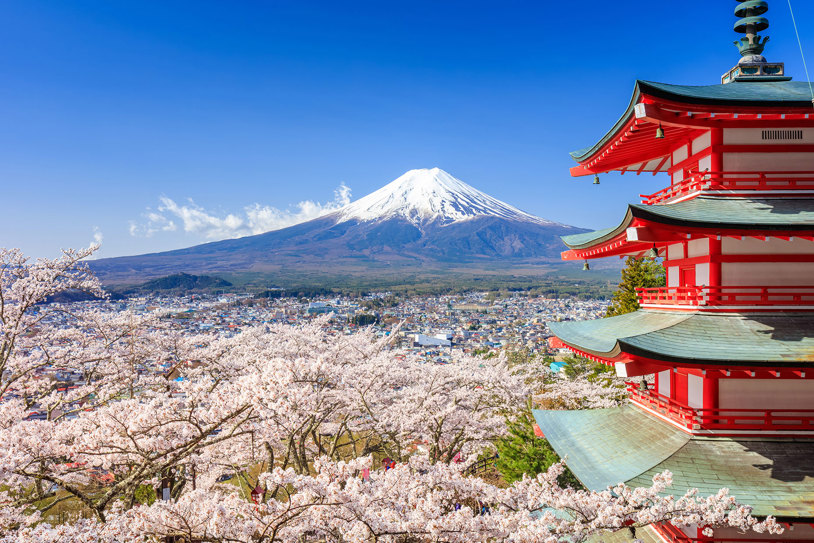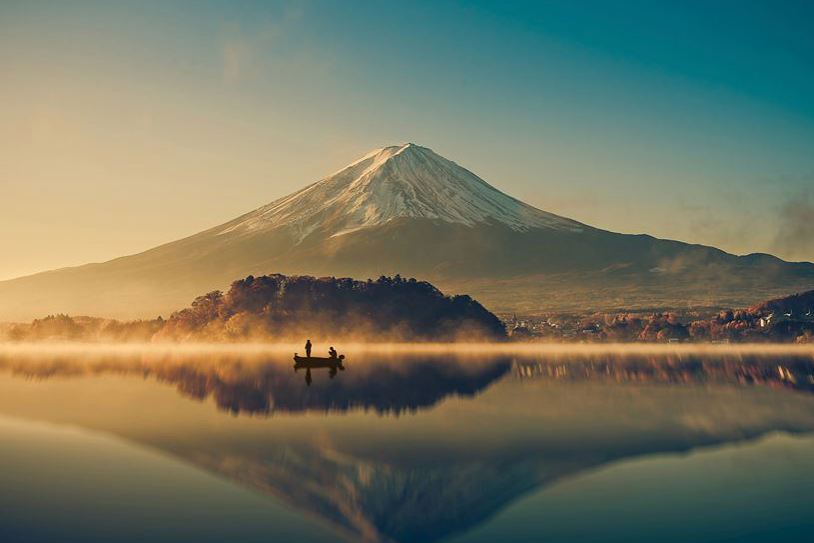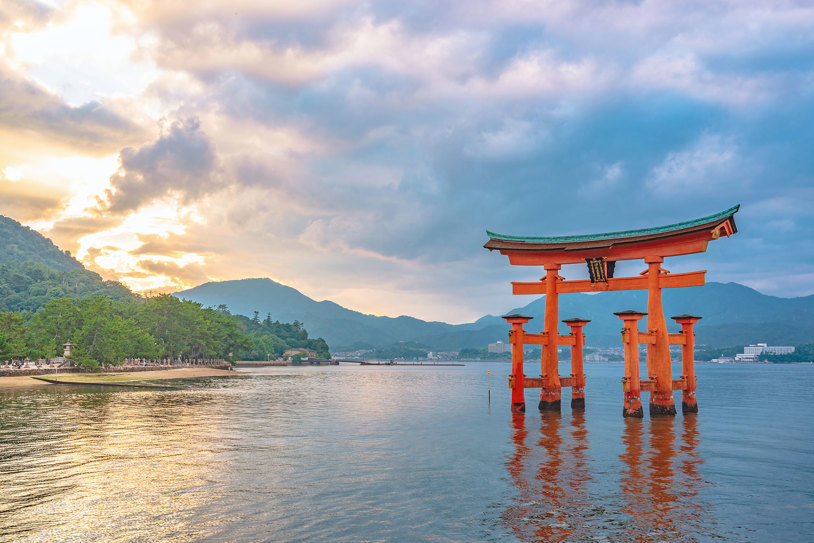Japan captivates visitors with its unique blend of ancient traditions, modern innovations, and breathtaking natural beauty, offering a diverse and enriching travel experience.
Japan Travel Guide
Itinerary Tips, What to See, and How to Plan

Visiting Japan is unforgettable, but planning a trip there can be a but daunting. From knowing when to go and what to see, to navigating etiquette and avoiding common mistakes, this travel guide shares everything you need to know before departure. Let our team help craft a well-paced journey that includes all the must-see moments without the stress of managing the details alone.
Planning a future visit or simply curious about what makes Japan unique? This guide offers a deeper look at the country and the highlights to expect on your tour.
Japan Essential Information
- Location: Japan is an island nation in East Asia, located in the Pacific Ocean. It consists of four main islands—Honshu, Hokkaido, Kyushu, and Shikoku—along with many smaller islands.
- Capital:Tokyo
- Language: Japanese
English is spoken in some hotels, train stations, and tourist areas, but not widely used in daily conversation. Learning a few basic phrases can enhance your experience. - Currency: Japanese Yen (JPY or ¥)
Cash is widely used, especially in rural areas. Credit cards are accepted in larger cities, hotels, and some shops. - Time Zone: Japan Standard Time (JST)
UTC plus 9 hours
Japan does not observe daylight saving time. - Plugs and Voltage: Plug Types A and B (same as used in North America)
Voltage: 100 volts
Frequency: 50 hertz in eastern Japan including Tokyo, and 60 hertz in western Japan including Kyoto and Osaka
Travelers should check their devices for compatibility. Some may require a voltage converter in addition to a plug adapter. - Climate: Japan has four distinct seasons.
Spring (March to May) offers mild temperatures and cherry blossoms.
Summer (June to August) is hot and humid, with occasional rain.
Autumn (September to November) brings crisp air and colorful foliage.
Winter (December to February) is cold, especially in the north and mountainous regions, with snowfall in many areas.
A Glimpse into Japanese Culture
Japanese culture is built on harmony, mindfulness, and deep respect for tradition. You'll discover it in the culture's everyday rituals, sacred spaces, preserved craftsmanship, and quiet moments of reflection. Travelers are welcomed to learn more about Japanese culture not only by visiting famous landmarks, but also by participating in the living history found in mountain villages, peaceful gardens, and vibrant neighborhoods.
Spiritual Traditions and Sacred Spaces
In cities and countryside alike, Japan’s spiritual heritage is ever-present. Visitors to Meiji Jingu Shrine in Tokyo or Heian-jingu Shrine in Kyoto encounter Shinto architecture surrounded by natural beauty. The Sensō-ji Temple in Asakusa is Tokyo’s oldest and draws visitors with its lanterns, incense, and the lively Nakamise shopping street that leads to its gate.
In Kyoto, the Golden Pavilion at Kinkaku-ji gleams above a tranquil pond. Nearby, Sanjusangen-do Hall displays 1,001 hand-carved statues of the goddess Kannon, each with a unique expression. On Miyajima Island, the Itsukushima Shrine stands in the sea, its torii gate appearing to float at high tide. These sacred places invite quiet reverence and reflection.
Traditional Arts and Local Craftsmanship
Japanese artistry is both refined and personal. In the mountain village of Gokayama, travelers meet local families and try their hand at washi paper-making, a delicate process passed down through generations. In Kanazawa, guests learn the skill of gold leaf painting, a practice that dates back to the 16th century. These hands-on experiences offer insight into the patience and precision that define Japanese craftsmanship.
At the Nomura Samurai House in Kanazawa’s Nagamachi District, visitors walk through well-preserved interiors once home to a respected samurai family. The house is a quiet reflection of Japan’s historical codes of honor, artistry, and domestic life.
Gardens, Castles, and Preserved Villages
Landscape and design are central to Japanese culture. In Kenroku-en Garden, considered one of Japan’s most beautiful, paths wind past still ponds and sculpted trees. The garden reflects seasonal beauty and careful composition. Nearby, the city of Takayama preserves Edo-era architecture, while Gokayama’s gassho-zukuri homes stand with steep thatched roofs, built without nails to withstand snow.
In Himeji, the white-walled castle known as the White Heron rises above the city. Its elegant structure and surrounding gardens are a testament to the architectural legacy of feudal Japan.
Food, Rituals, and Everyday Grace
Cultural expression is woven into daily life. Travelers take part in a sushi-making session in Ginza, try Hida-gyu beef in Takayama, and enjoy okonomiyaki in Hiroshima. Markets like Nishiki in Kyoto and Omicho in Kanazawa display the value of seasonal ingredients and local pride. Even a stroll through Ameyoko Market in Tokyo reveals the rhythm of daily life and commerce.
Hospitality in Japan is expressed through attention to detail, whether it is the placement of a meal, the arrangement of a garden, or the respectful bow of a guide. Across every region, travelers are invited to engage, learn, and reflect through cultural exchange that is quiet, powerful, and lasting.
Food and Drink in Japan
Japanese cuisine is not just about what is served on the plate, it is about when, where, and how it is enjoyed. From coastal cities to mountain villages, meals reflect a deep appreciation for ingredients and presentation. Flavors are clean and intentional, with dishes often highlighting just a few high-quality elements. Rice, seafood, vegetables, and fermented foods are staples, served in harmonious combinations.
Popular Dishes
Sushi and Sashimi: Delicately prepared raw fish and vinegared rice, often served with fresh wasabi, pickled ginger, and soy sauce. Sushi chefs across Japan take pride in their craft, especially in cities like Tokyo and Kanazawa.
Okonomiyaki: A savory grilled pancake layered with shredded cabbage, noodles, egg, and toppings like seafood, pork, or cheese. Hiroshima-style okonomiyaki is known for its layered approach and hearty flavors.
Hida-Gyu: Premium Japanese beef from the Hida region, known for its marbling and tenderness. It is often served grilled or seared to highlight its natural richness.
Nabe (Hot Pot): Hot pot meals in Japan are generally referred to as "nabe" (pronounced nah-beh), which literally means "pot." Thinly sliced beef is severed along with vegetables and noodles to a shallow pot with a sweet and savory broth. These meals are especially common in colder months and are often enjoyed socially, with friends or family gathered around a simmering pot. Our favorite variation to try is Shabu-Shabu.
Matcha Sweets: Green tea powder is used in everything from soft-serve ice cream to cakes and confections. These earthy, slightly bitter treats are especially popular in Kyoto, where tea culture runs deep.
Seafood Bowls: Coastal markets serve donburi-style rice bowls topped with local fish, roe, and shellfish. Omicho Market in Kanazawa is one of the best places to try ultra-fresh regional seafood.
Manjū: Soft, steamed cakes filled with sweet red bean paste, often shaped like maple leaves or other symbols. A specialty on Miyajima Island, these are traditional, shareable, and easy to take on the go.
Beverages of Japan
Japan is home to some of the world’s finest beverages, both alcoholic and nonalcoholic. Sake, brewed from polished rice, is a signature drink and varies by region. You'll also find Japanese whisky, plum wine (umeshu), and a wide variety of green teas, each enjoyed with their own traditions. In places like Osaka and Kyoto, drinks often accompany multi-course meals or are enjoyed socially in izakayas and teahouses.
Must-See Destinations in Japan
- Tokyo: Meiji Shrine, Sensō-ji Temple, Sumida River cruise, Ameyoko Market.
- Mt. Fuji: 5th Station, Oshino Hakkai, Lake Ashi.
- Takayama & Gokayama: Edo-period architecture and washi paper-making.
- Kanazawa: Kenroku-en Garden, Omicho Market, Nomura Samurai House.
- Kyoto: Golden Pavilion, Fushimi Inari, Gion, Arashiyama Bamboo Grove.
- Nara: Todai-ji and the sacred deer of Nara Park.
- Hiroshima: Peace Memorial Park and Museum.
- Miyajima Island: Itsukushima Shrine and floating torii.
- Himeji & Osaka: Visit Himeji Castle and enjoy city life in Dotonbori.
Top 6 Do's and Don'ts When Traveling in Japan
Do:
- Remove your shoes indoors
In homes, temples, traditional inns, and even some restaurants, it’s customary to take off your shoes at the entrance. Look for designated areas and provided slippers. - Bow as a greeting
Bowing is a common and respectful way to say hello, thank you, or goodbye. A simple, polite bow is always appreciated. - Speak quietly in public spaces
Whether you’re walking through a market or dining out, low voices are a sign of good manners. - Queue patiently
Lining up in an orderly fashion is expected in stations, elevators, and shops. Even at busy street crossings, people wait their turn with calm and consideration. - Carry cash
Credit cards are accepted in many places, but small shops, markets, and some rural areas often operate on cash. - Learn a few Japanese phrases
A simple “arigatou gozaimasu” (thank you) or “sumimasen” (excuse me) can go a long way.
Don't:
- Don’t eat while walking
Street food is popular in many places, but it’s considered impolite to eat on the go. Pause and enjoy your snack in one spot. - Don’t talk on the phone on trains
Phones are often set to silent, and voice calls are discouraged on public transportation. Messaging or browsing quietly is the norm. - Don’t tip at restaurants
Tipping is not a part of Japanese culture and may even be refused. Great service is included in the experience. - Don’t point or gesture with chopsticks
Avoid pointing, waving, or stabbing food with chopsticks. When not in use, rest them on the holder or bowl. - Don’t blow your nose in public
If you need to step away to blow your nose, do so discreetly. Sniffling is considered more polite than loud nose blowing. - Don’t wear shoes on tatami mats
Tatami mats are delicate and sacred in many settings. Even indoor slippers should be removed before stepping on them.
Language & Practical Tips
Language Tips
Japanese is the national language, and while English is spoken in some hotels, shops, and tourist areas, it may be limited, especially outside major cities. A few polite Japanese phrases can make a meaningful impression and are always appreciated.
- Hello: Konnichiwa
- Thank you: Arigatou gozaimasu
- Please: Onegaishimasu
- Yes: Hai
- No: Iie
- I don’t speak Japanese: Nihongo wa hanasemasen
- Do you speak English?: Eigo o hanasemasu ka?
If you're not confident speaking, pointing politely and using translation apps can be helpful in shops or restaurants.
Practical Tips
Whether you are ordering a meal, browsing a market, or traveling by train, small gestures of politeness go a long way in Japan.
Tipping: Tipping is not customary in Japan and is often refused. Instead, exceptional service is built into the culture. A sincere thank you is more than enough.
Water: Tap water is safe to drink throughout the country. You’ll also find vending machines with bottled drinks almost everywhere.
Safety: Japan is known for its low crime rate and general safety. You can feel comfortable exploring both large cities and smaller towns, but as always, keep an eye on your belongings in busy areas.
Shopping: From handcrafted pottery to regional food specialties, Japan is a shopper’s delight. Many stores accept credit cards, but smaller businesses may prefer cash. ATMs are common and many convenience stores offer international-friendly machines.
Etiquette Reminder: Carry a small bag for any trash, as public bins can be rare. It is polite to sort recyclables and dispose of them properly when you return to your hotel or accommodation.
When to Visit
- Spring: Cherry blossoms in Kyoto and Tokyo draw visitors worldwide.
- Autumn: Colorful foliage and crisp air create ideal conditions for sightseeing.
- Summer and Winter: Consider alpine regions, festivals, or hot springs depending on your interests.
Explore Japan on a Guided Tour
Japan invites you to experience a harmonious blend of ancient tradition and modern wonder. From serene temple gardens in Kyoto to the bustling markets of Kanazawa and the bright lights of Tokyo, this is a country where every detail matters and every moment is a chance to connect more deeply with the culture.
Our guided tours are designed to take the stress out of planning so you can focus on discovery. With thoughtfully arranged accommodations, seamless travel, and expert Travel Directors who share insight at every step, you’ll enjoy a smooth, enriching journey through Japan’s most iconic and culturally significant destinations.
From learning the rhythms of Taiko drumming in Tokyo to walking under the vibrant torii gates at Fushimi Inari Shrine, each day brings a new highlight. Witness the resilient spirit of Hiroshima, explore the timeless charm of Takayama’s Old Town, or admire the gold-draped beauty of Kinkaku-ji. Along the way, you’ll enjoy authentic meals, peaceful garden strolls, and breathtaking views of Mt. Fuji.
Join us on a guided tour of Japan where every detail is taken care of and every experience is designed to bring you closer to the heart of this unforgettable destination. Whether you are sipping green tea in a traditional ryokan or wandering stone streets once traveled by samurai, Japan offers memories that stay with you long after your return.
What You Can Experience on a Portugal Tour
Featured Japan Tour Experiences
Walk the quiet paths of ancient temple grounds and lively city streets filled with color and energy. From gardens tucked behind shrines to modern neighborhoods buzzing with creativity, Japan invites you to explore with curiosity and wonder.
Glide across scenic lakes beneath views of Mt. Fuji and float past skyline reflections on the Sumida River.
Visit centuries-old temples, sacred shrines, and peace memorials that speak to Japan’s spiritual and cultural strength.
Enjoy immersive meals that celebrate regional flavors, from expertly crafted sushi to sizzling okonomiyaki.
Spend time in both iconic cities like Tokyo and Kyoto and preserved towns like Takayama and Kanazawa, each offering its own rhythm and charm.
Harmony of Past and Present
Experience Japan’s living history in places where tradition continues to shape daily life. On a guided tour, you’ll gain insight into the meaning and symbolism behind each place. With the help of local experts, you can connect to the culture in deeper, more meaningful ways. Stroll through the Edo-era streets of Takayama, admire the gassho-style homes of Gokayama, or explore samurai residences in Kanazawa’s Nagamachi District. Whether you are standing before the Golden Pavilion in Kyoto or walking the grounds of Himeji Castle, each site reveals a new layer of Japan’s story.
Flavors Worth Traveling For
From bustling markets to tranquil teahouses, Japanese cuisine is as much about experience as it is about taste. Learn to make sushi with a professional chef, try Hida beef in the Japanese Alps, and enjoy a traditional okonomiyaki lunch in Hiroshima.
At markets like Nishiki in Kyoto and Omicho in Kanazawa, discover fresh produce, regional sweets, and local snacks prepared with care. Your guides will introduce you to flavors that define each region and help you understand the culture through its cuisine.
Natural Beauty in Every Season
Japan’s landscapes offer quiet beauty year-round. With guided transportation and time built in for walking, photos, and reflection, when you go guided, you enjoy every natural scene without needing to navigate it alone. Ride a ropeway for panoramic views over Lake Ashi, stroll through one of the country’s most celebrated gardens in Kanazawa, or take in the symmetrical majesty of Mt. Fuji from its 5th Station.
Cultural Encounters and Artful Traditions
Take part in cultural exchanges that offer more than observation. Learn the art of gold leaf painting, craft washi paper with local artisans, or witness the energy of a taiko drumming performance. Visit historic districts, open-air markets, and quiet workshops where the heart of Japanese culture comes to life. Each experience is designed to foster connection with the people and practices that shape Japan today.
Effortless Travel with Guided Expertise
Let us take care of the details so you can enjoy your journey fully. Whether you are admiring temple rooftops in Kyoto or tasting your way through a neighborhood market, your guided tour ensures you travel with ease and insight. Every Japan tour includes vetted accommodations, smooth transportation, and a thoughtfully paced itinerary. With expert Travel Directors and knowledgeable local guides, you’ll be supported from start to finish by a team who knows Japan and loves to share it.






















